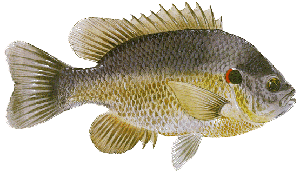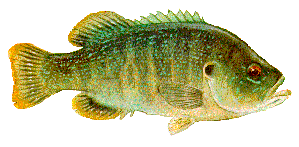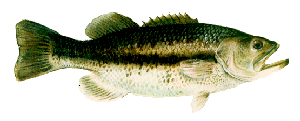BIOL 1400 -- Lecture Outline 5
"Freedom begins between the ears." --Edward Abbey
I. So how many kinds of living things are there?
- Biological definition of a species: A set of organisms that can
potentially interbreed to give rise to fertile offspring.
- This is not a perfect definition, but we still use it frequently; it's
convenient and useful in most of the cases that you will encounter.
- A little perspective. . .
- Humanity forms one species. . .
- We're grouped in the Mammalia, which consists of about 4,000 species of mammals
(animals with hair, warm blood, producing milk, etc.) Almost half of all mammal
species are rodents, and about another fourth are bats.
- Add the birds, reptiles, amphibians, and fish. . . you get about 50,000 species
of vertebrate (animal with a backbone).
- But 50,000 species is nothing. There are over 70,000 species of arachnid
(spiders, scorpions, mites, ticks, etc.) There are over 100,000 known species of ants,
bees, and wasps. There are nearly 300,000 known species of beetle. . . .
- . . . about 250,000 species of land plant, most of which (220,000 species) are
flowering plants (the rest are mosses, ferns, conifers, and other planta that don't
flower). . .
- . . . in all, about 1.5 million known species of organism are known to exist today.
- But that's certainly an underestimate. Previously unknown species are still
being discovered.
- Current estimates for the actual number of species on Earth usually range
from 5 million to 50 million. 10 million is a fairly reasonable, conservative estimate,
but no one really knows.
- It is necessary to have a standardized way of naming species, so that
biologists can be sure they're all talking about the same thing.
- We also have to have a stable, standardized way of classifying living things --
with 1.5 million named species to keep track of.
- What's this fish called?

- Some of you would call it a "bluegill", some a "bream", and some a
"perch". In other parts of the country, "sunfish", "sunperch", or "panfish" is the
usual name.
- And that's just in English! In Russian, for instance, this is a sinezhabernyy
solnechnik. This could get confusing fast, especially since science very often
involves international collaboration.
- An 18th-century Swedish botanist named Carl Linnaeus developed
a convention for naming and classifying species that we still use (with some
modification). (Here's
some more information on Linnaeus, for anyone who's interested. . .)
- Greek philosophers such as Aristotle had said that, to classify something, you
had to do two things:
- Identify the general kind of thing it is (its genus, plural genera) --
what makes it similar to other things?
- Identify what makes it different from all other things like it (its species,
plural also species)
- Linnaeus used that philosophy to devise a system of binomial nomenclature
(binomial = "two names"):
- A species' complete name is its genus name followed by its species name.
- This name is in Latin, and should always be written in italics or be underlined.
- Whoever first discovers a new species, and officially describes it, gets to
name it. This is still going on today.
- Look at the bluegill again (or is it a perch?)

This fish has exactly one unique Latin name -- Lepomis macrochirus.
- Any biologist, no matter where she's from or what her native
language is, will recognize and understand that name, or at least will know
where to look it up.
- The bluegill sunfish (Lepomis macrochirus) is quite similar to other
fish, which we classify in the same genus. . .

Lepomis microlophus (the red-ear sunfish)

Lepomis cyanellus (the green sunfish)
- Linnaeus's other innovation was the use of hierarchical classification.
- Species are grouped together in genera. . .
- then those may be grouped in more inclusive groups, and so on.
(Each of these groups is called a taxon.)
- Usually, each taxon is assigned a rank depending on how inclusive it is.
- Starting from the top, the basic taxon ranks are:
Kingdom
Phylum
Class
Order
Family
Genus
Species
- Sunfishes (genus Lepomis) resemble bass (Micropterus
salmoides is the largemouth bass, Micropterus dolomieui is the
smallmouth bass) in many ways

Micropterus salmoides, the largemouth bass
- Thus the genera Lepomis,
Micropterus, and some others all go in the same family, whose
Latin name is Centrarchidae.
- The family Centrarchidae goes together with many other families of fish
into an order called Teleostei, consisting of fish with symmetrical tails
and mouths . . .
- The order Teleostei goes together with some others into a class
called Osteichthyes, consisting of all fish with rayed fins and a bony skeleton. . .
- The class Osteichthyes goes with some others into the phylum
Chordata, which includes all animals with a nerve cord running down the back. . .
- And the phylum Chordata goes with some others into the kingdom
Animalia, which includes all multicelled organisms with complex embryonic
development, collagen proteins, etc.
- Here are the taxa into which our species, Homo sapiens, falls:
Kingdom: Animalia (heterotrophic organisms with many cells of many
specialized types, embryonic development, collagen proteins)
Phylum: Chordata (animals with a spinal cord)
Class: Mammalia (chordates with hair and milk glands)
Order: Primates (mammals with five grasping fingers and toes, good vision,
relatively large brains, forward-facing eyes with complete bony eye sockets)
Family: Hominidae (primates lacking tails)
Genus: Homo (hominids with upright posture, tool use)
Species: sapiens (Homo with brain size about 1300 cm3)
Go to Previous Notes |
Return to Lecture Schedule |
Return to Syllabus |
Contact the Prof |
Go to Next Notes




